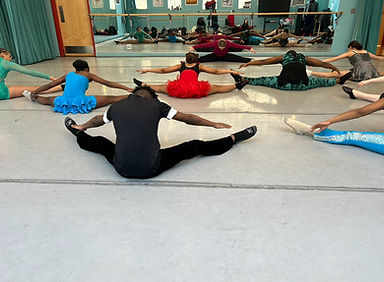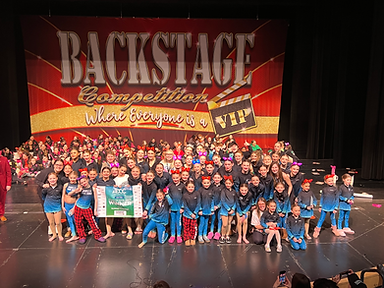Teaching Philosophy
My teaching philosophy follows the concepts of Howard Gardner's Theory of Multiple Intelligences, Ken Robinson's Do Schools Kill Creativity Ted Talk, and the connection of the mind, body, and feelings. These concepts are all applied to my day-to-day teaching.

"A dance teacher helps students find the song in their hearts, the beat in their feet, and a passion for life."
- Unknown


"Thanks to dance... I have come out of my shell and made memories that will last a lifetime."
- Unknown
Howard Gardner's Theory of Multiple Intelligences is a concept I carry into all of my lessons. When in grade school we were always told there were three different types of learners. These include auditory, kinesthetic, and visual learners. This excludes many other learning types and styles. Gardner's theory states that there are a total of eight different intelligences. These are, linguistic, logical-mathematical, spatial, bodily-kinesthetic, musical, interpersonal, interpersonal, and naturalist. As an educator, I do my best to ensure I am meeting the needs of all the different intelligences in my classroom. I have a wide array of assignments to aid all students. After taking the quiz to assess what intelligence I have, I have been able to play into my strengths as a student and educator. If you would like to assess your intelligences please click the link below that will take you to the questionnaire.
https://www.literacynet.org/mi/assessment/findyourstrengths.html
All students have different talents that we as teachers need to take into consideration. Dance offers a space that makes this possible. In Ken Robinson’s “Do Schools Kill Creativity?” Ted Talk, he speaks very passionately about how it's a necessity to include Arts in schools. Ken touches upon the fact that no study area should be valued more than the other. This being said Math isn’t more important than English nor is Dance more important than PE or Science. “Real Education has to give equal weight to the arts, the humanities, and physical education” (4:53). For students to thrive in any learning environment they need to be motivated and feel as though they will succeed in their learning. Dance provides the space to engage students by giving them choices. As well as, presents opportunities for students to be individuals, relate to whatever they are interested in in their learning, and learn in the domain they work best. Assisting students in understanding themselves, their interests, and the world around them is something only dance can do. Creative dance provides students with open-ended questions to stimulate basic and critical thinking. Asking young students what a leaf looks like floating in the wind, leaves an opening for students to show this in any way they would like. Asking students to compose a dance piece challenges them to critically think, analyze their work, edit and revise, and critique your self and others. Composing a dance also leaves students complete creative freedom so they may express themselves however they choose. Knowing that all human life is naturally creative, it is a must that dance education is implemented into all school curriculums.
For students to reach their full academic potential, students need to use their kinesthetic, cognitive, and affective domains of learning. Their mind, body, and spirit need to work as a whole to promote full learning capacity. Dance being kinesthetic based, is already covering the body portion. However, dance also covers cognitive and affective learning, the mind and spirit are largely valued aspects of dance education. When asking students to create a research-based dance they would be, staring by picking a topic they feel strongly about touching upon their affectrive learning by using their feelings. Then they would research and take notes on this topic, finding a dance work related to their chosen topic using their cognitive learning. Next, they would compose the dance, in this process, they are editing and revising their work as they go, touching again upon their cognitive learning. Lastly, they would perform their piece for others using the kinesthetic learning domain. Using movement in our classrooms helps stimulate brain activity, whereas sitting for long periods slows down our cognitive progression. Eric Jensen quoted that movement can, “activate far more brain areas than traditional seatwork.” Kids use their bodies to communicate their emotions frequently. Since students can’t move around in the classroom, we must have dance education classes to give them the space to release all the pent-up energy and help improve their cognitive development.
Teacher Values
Below I have listed 10 of my most important teaching values that I carry with me into every lesson I teach. These are a helpful tool to keep me motivated and excited about fostering a healthy learning environment.
1. Achievement –I will always celebrate all my students as well as my achievements of any size. We will as a class have small rewards for all of our achievements, no matter how big or small. All will be celebrated.
2. Being the Best – I will always be my best and promote that value to my students as well. I love to learn more and always better myself as a teacher. I will continue to further my education post-graduation. I will attend master classes, seminars, and workshops to continue learning and growing to be the best I can be.
3. Community – I want my classroom community to be the best space in the building. We will always start class in a circle sharing a piece of our day, whether this is verbally or on paper. My classroom with be a safe, welcoming space. Students will feel comfortable and calm in my classroom space.
4. Excitement – I will create a very exciting environment. I have high energy and am always showing my students I’m excited about our learning. I will be proud of the work being done in the classroom. I will create out-of-the-box lessons relating to pop culture.
5. Fairness – I will be fair to each student of mine. I will to take their outside factors into play when looking to accommodate for them to keep all learning equal between my students.
6. Gentleness – I want to teach with gentleness in mind. Always being kind and understanding to my students and their circumstances. My students do not need to be afraid of me because of my actions. I will be the safe space for them to come to.
7. Leadership – I will be reminded of my leadership role in the classroom. Remembering that my students will look up to me as a role model. I am a leader and it transfers into the classroom.
8. Passion – I will always teach with passion in mind. Teaching is my passion and on my bad days, I need to remind myself of that. I have many posters and quotes that I live by to inspire passion. I want to carry this idea through my whole teaching career.
9. Reliability – I will be a reliable person for my students. I want them to be able to come to me with any problems they may face and know that their personal lives and information is safe with me.
10. Thoughtfulness – I will always put a lot of thought into my lessons ensuring that they are engaging and exciting. I will think through every lesson and activity to make sure it will play out correctly.